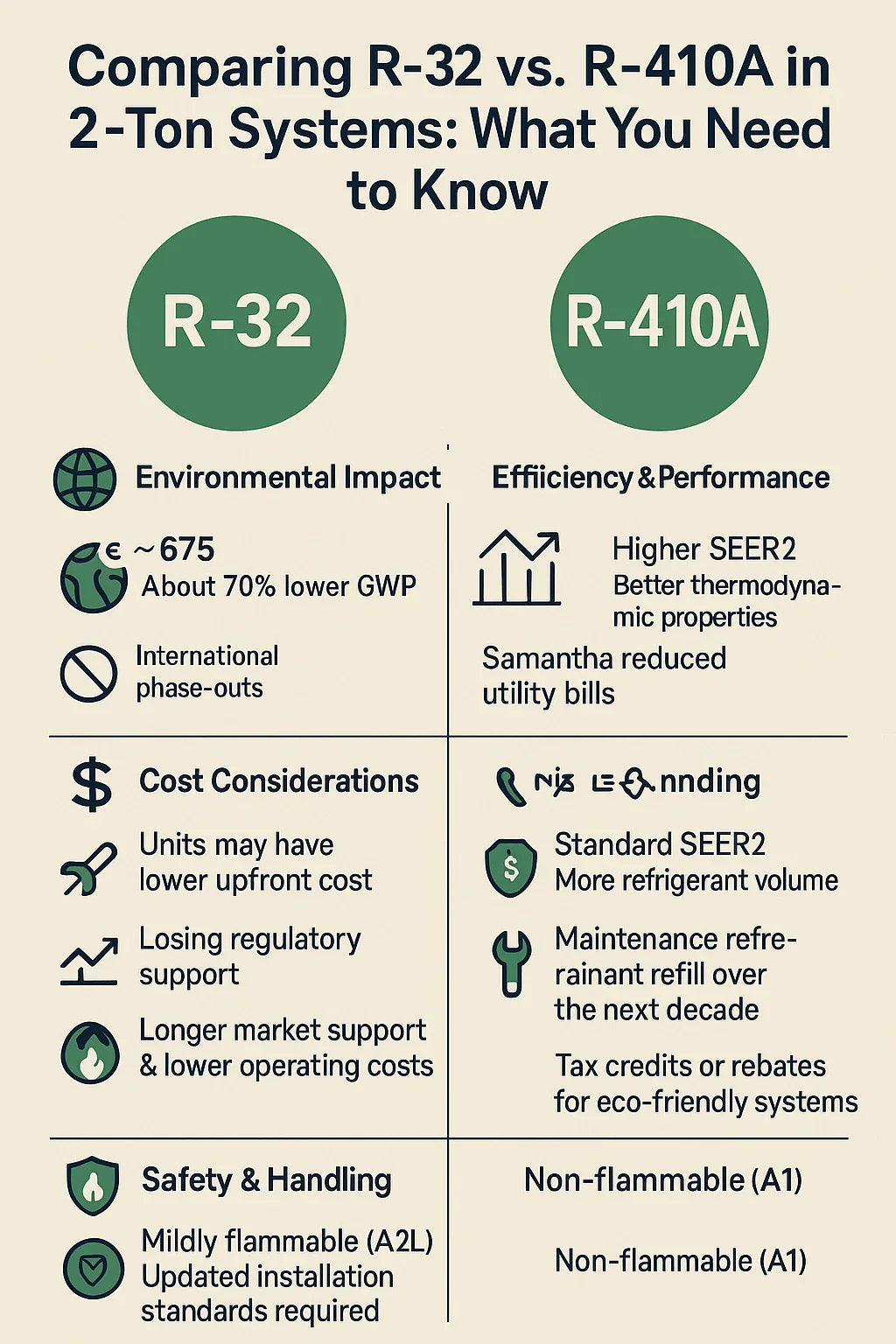🏠 Introduction: Why Your Refrigerant Choice Matters
Choosing the right refrigerant—R‑32 or R‑410A—is about more than just cooling your home. It affects your energy bills, long‑term environmental footprint, installation requirements, and even system longevity. In 2025, refrigerant regulations and efficiency standards are shifting, making this decision more important than ever.
As a homeowner invested in comfort, budget, and the planet, here’s everything you need to know about these two common refrigerants. Click any section below to jump directly to it:
-
Environmental Impact
-
Efficiency & Performance
-
Cost: Upfront & Operating
-
Safety & Handling
-
Regulatory Trends & Future‑Proofing
-
Climate Suitability in 2‑Ton Systems
-
Samantha’s Summary & Takeaway
🌍 1. Environmental Impact: The GWP Difference
-
R‑410A: GWP ~2,088 (no ozone depletion potential)
-
R‑32: GWP ~675 (also zero ozone depletion)
That’s nearly a 70 % reduction in climate impact when opting for R‑32 over R‑410A. R‑32's single‑component chemistry also makes recycling and reclaiming far easier than R‑410A blends
Major regulatory drivers like the Kigali Amendment and the U.S. AIM Act are phasing down high‑GWP refrigerants—R‑410A included—making R‑32 the more sustainable, longer‑term choice
⚙️ 2. Efficiency & Performance in 2‑Ton Systems
-
R‑32 offers better thermodynamic properties and heat transfer.
-
It requires 20–30% less refrigerant than R‑410A for the same cooling output
-
The reduced refrigerant charge translates to lower compressor work—leading to higher SEER2 ratings and lower electricity use
-
HVAC studies show typical R‑32 units use 10–30% less power than comparable R‑410A units
💰 3. Cost Overview: Upfront vs. Long-Term
Upfront Costs
-
R‑32 and R‑410A equipment are priced similarly. However, R‑32 may slightly cost more in markets still transitioning to it
Long-Term Savings
-
With R‑32’s higher efficiency, expect lower operational costs.
-
Less refrigerant volume = cheaper refill and maintenance.
-
Many utilities and ENERGY STAR programs offer rebates or tax credits for installing low‑GWP systems in 2025+
Future Serviceability
-
R‑410A will become increasingly scarce and expensive to service.
-
R‑32 systems are already mainstream and supported for years to come
🔧 4. Safety & Installation Concerns
-
R‑410A is A1 rated (non‑flammable and non‑toxic).
-
R‑32 is A2L rated—mildly flammable, but safe when installed by trained professionals with correct ventilation and leak detection systems
Certified technicians must follow updated protocols for R‑32 installations, which adds a layer of safety. Samantha made sure her installer was A2L‑trained before moving forward.
📜 5. Regulatory Trends & Future-Proofing
-
Per the U.S. AIM Act, R‑410A production is being phased out rapidly starting in 2022, with stricter limits through 2025 and beyond
-
In the EU, R‑410A use in split AC units with less than 3 kg refrigerant will be banned beginning in 2025–2027 depending on category
-
Meanwhile, R‑32 has broad global regulatory support, making it the industry’s direction of travel
🌡️ 6. Climate Suitability: How Refrigerants Perform
Hot / Humid Zones
R‑32 handles high-load, humid conditions more efficiently due to better heat transfer and reduced refrigerant volume.
Moderate Climates
Both refrigerants work. R‑32 saves more in energy over time and aligns with green building credits.
Cooler Climates / Heat Pumps
Many R‑32 heat pump models deliver better low‑ambient heating performance and efficiency compared to older R‑410A models
📊 Side‑by‑Side Comparison Table
| Feature | R‑32 (2‑Ton) | R‑410A (2‑Ton) |
|---|---|---|
| Global Warming Potential (GWP) | ~675 | ~2,088 |
| Ozone Depletion Potential (ODP) | 0 | 0 |
| Efficiency | Higher (better SEER2 ratings) | Lower |
| Refrigerant Volume Needed | ~20–30% less | More |
| Flammability Rating | Mild (A2L) | Non‑flammable (A1) |
| Safety Requirements | A2L-certified install needed | Standard HVAC install |
| Recycling / Reclaiming | Easier (single component) | Complex (zeotropic blend) |
| Market Longevity | Widely adopted and future‑proof | Being phased out |
| Upfront Cost | Slightly higher in some markets | Moderate |
✅ Samantha’s Takeaway: What Should You Choose?
If you're buying a new 2‑ton AC system in 2025, R‑32 is the smarter choice:
-
It lowers your environmental impact significantly.
-
It saves energy and money over the system’s lifetime.
-
It's aligned with global refrigerant regulations—whereas R‑410A is being phased out.
-
As long as you work with a pro trained in R‑32 installation, safety is well-managed.
While R‑410A still has reliability and familiarity, its long-term viability is fading fast. If you're thinking beyond today—about efficiency, regulations, and sustainability—R‑32 is clearly the future.
💡 Final Thoughts for Samantha and Savvy Homeowners
Whether you're upgrading or building new, choosing the right refrigerant matters. R‑32 in a properly matched 2‑ton system gives you:
-
Reduced carbon footprint
-
Lower long‑term energy costs
-
Confidence that your HVAC is compliant now and in the future
Work with certified installers, ask about rebates, and look for AHRI‑ and SEER2‑rated R‑32 systems—that’s how you turn smart tech into smart savings.
In the next topic we will know more about: Installation Costs for a 2‑Ton R‑32 AC System in 2025: What Samantha Learned







